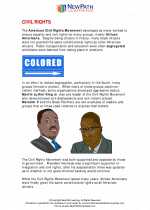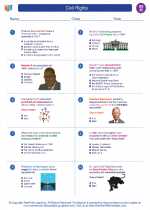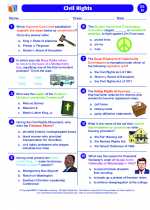Civil Rights
The American Civil Rights Movement developed as many worked to ensure equality and civil rights for many groups, mainly African Americans. Despite being citizens in theory, many black citizens were not granted the same constitutional rights as other American citizens. Read More...
◂Social Studies Worksheets and Study Guides Eighth Grade. Civil Rights
Study Guide Civil Rights
Civil Rights  Worksheet/Answer key
Worksheet/Answer key Civil Rights
Civil Rights  Worksheet/Answer key
Worksheet/Answer key Civil Rights
Civil Rights  Worksheet/Answer key
Worksheet/Answer key Civil Rights
Civil Rights  Worksheet/Answer key
Worksheet/Answer key Civil Rights
Civil Rights 

 Worksheet/Answer key
Worksheet/Answer key
 Worksheet/Answer key
Worksheet/Answer key
 Worksheet/Answer key
Worksheet/Answer key
 Worksheet/Answer key
Worksheet/Answer key

The resources above cover the following skills:
National Curriculum Standards for Social Studies (NCSS)
POWER, AUTHORITY, AND GOVERNANCE
SOCIAL STUDIES PROGRAMS SHOULD INCLUDE EXPERIENCES THAT PROVIDE FOR THE STUDY OF HOW PEOPLE CREATE, INTERACT WITH, AND CHANGE STRUCTURES OF POWER, AUTHORITY, AND GOVERNANCE.
PROCESSES - Learners will be able to:
Examine persistent issues involving the rights of individuals and groups in relation to the general welfare.
Compare and analyze the ways in which groups and nations respond to the richness of unity and diversity, as well as tensions and conflicts associated with unity and diversity.
CIVIC IDEALS AND PRACTICES
SOCIAL STUDIES PROGRAMS SHOULD INCLUDE EXPERIENCES THAT PROVIDE FOR THE STUDY OF THE IDEALS, PRINCIPLES, AND PRACTICES OF CITIZENSHIP IN A DEMOCRATIC REPUBLIC.
KNOWLEDGE - Learners will understand:
Concepts and ideals such as: individual dignity, liberty, justice, equality, individual rights, responsibility, majority and minority rights, and civil dissent.
Key documents and excerpts from key sources that define and support democratic ideals and practices (e.g., the U.S. Declaration of Independence, the U.S. Constitution, the Gettysburg Address, the Letter from Birmingham Jail; and international documents such as the Declaration of the Rights of Man, and the Universal Declaration of the Rights of Children).
PROCESSES - Learners will be able to:
Evaluate the significance of public opinion and positions of policymakers in influencing public policy development and decision-making.
Evaluate the degree to which public policies and citizen behaviors reflect or foster their stated democratic ideals.
National Standards for Civics and Government (NSCG)
What are the foundations of the American political system? What are the distinctive characteristics of American society?
Diversity in American society. Students should be able to evaluate, take, and defend positions on the value and challenges of diversity in American life. To achieve this standard, students should be able to
Explain why conflicts have arisen from diversity, using historical and contemporary examples, e.g., North/South conflict; conflict about land, suffrage, and other rights of Native Americans; Catholic/Protestant conflicts in the nineteenth century; conflict about civil rights of minorities and women; present day ethnic conflict in urban settings
What are the foundations of the American political system? What is American political culture?
The character of American political conflict. Students should be able to describe the character of American political conflict and explain factors that usually prevent violence or that lower its intensity. To achieve this standard, students should be able to
Describe political conflict in the United States both historically and at present, such as conflict about
Extending civil rights to all Americans
What are the foundations of the American political system? What values and principles are basic to American constitutional democracy?
Fundamental values and principles. Students should be able to explain the meaning and importance of the fundamental values and principles of American constitutional democracy. To achieve this standard, students should be able to
Identify fundamental values and principles as expressed in
Individual and group actions that embody fundamental values and principles, e.g., suffrage and civil rights movements
Disparities between ideals and reality in American political and social life. Students should be able to evaluate, take, and defend positions on issues concerning ways and means to reduce disparities between American ideals and realities. To achieve this standard, students should be able to
Explain, using historical and contemporary examples, discrepancies between American ideals and the realities of political and social life in the United States, e.g., the ideal of equal justice for all and the reality that the poor may not have equal access to the judicial system.
Describe historical and contemporary efforts to reduce discrepancies between ideals and the reality of American public life, e.g., abolition, suffrage, civil rights, and environmental protection movements
How does the government established by the constitution embody the purposes, values, and principles of American democracy? What does the national government do?
Major responsibilities for domestic and foreign policy. Students should be able to explain the major responsibilities of the national government for domestic and foreign policy. To achieve this standard, students should be able to
Identify historical and contemporary examples of important domestic policies, e.g., Pure Food and Drug Act, Environmental Protection Act, civil rights laws, child labor laws, minimum wage laws, Aid to Families with Dependent Children, Social Security
Explain how and why domestic policies affect their lives
How does the government established by the constitution embody the purposes, values, and principles of American democracy? How does the American political system provide for choice and opportunities for participation?
The public agenda. Students should be able to explain what is meant by the public agenda and how it is set. To achieve this standard, students should be able to
Describe how the public agenda is shaped by political leaders, interest groups, the media, state and federal courts, individual citizens
Associations and groups. Students should be able to explain how interest groups, unions, and professional organizations provide opportunities for citizens to participate in the political process. To achieve this standard, students should be able to
Describe the historical roles of prominent associations and groups in local, state, or national politics, e.g., abolitionists, suffragists, labor unions, agricultural organizations, civil rights groups, religious organizations
Forming and carrying out public policy. Students should be able to explain how public policy is formed and carried out at local, state, and national levels and what roles individuals can play in the process. To achieve this standard, students should be able to
Define public policy and identify examples at local, state, and national levels
Describe how public policies are formed and implemented
What are the roles of the citizen in American democracy? How can citizens take part in civic life?
Forms of political participation. Students should be able to describe the means by which Americans can monitor and influence politics and government. To achieve this standard, students should be able to
Describe historical and current examples of citizen movements seeking to promote individual rights and the common good, e.g., abolition, suffrage, labor and civil rights movements
National Center for History in Schools (NCHS)
Historical Thinking Standards
Historical Comprehension
Reconstruct the literal meaning of a historical passage.
United States History Content Standards
Era 5: Civil War and Reconstruction (1850-1877)
How various reconstruction plans succeeded or failed.
The student understands the successes and failures of Reconstruction in the South, North, and West.
Era 6: The Development of the Industrial United States (1870-1900)
The rise of the American labor movement and how political issues reflected social and economic changes.
The student understands how Americans grappled with social, economic, and political issues.
Era 9: Postwar United States (1945 to early 1970s)
Domestic policies after World War II.
The student understands the political debates of the post-World War II era.
The struggle for racial and gender equality and the extension of civil liberties.
The student understands the “Second Reconstruction” and its advancement of civil rights.
Era 10: Contemporary United States (1968 to the present)
Recent developments in foreign and domestic politics.
The student understands domestic politics in contemporary society.